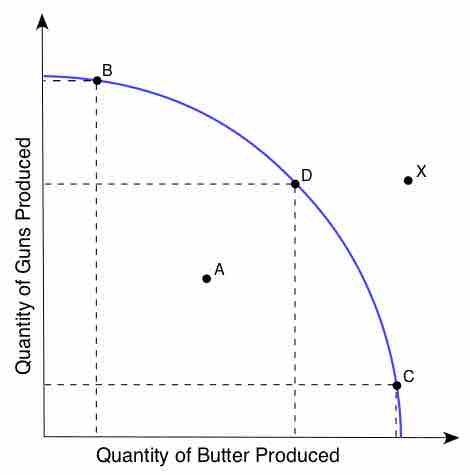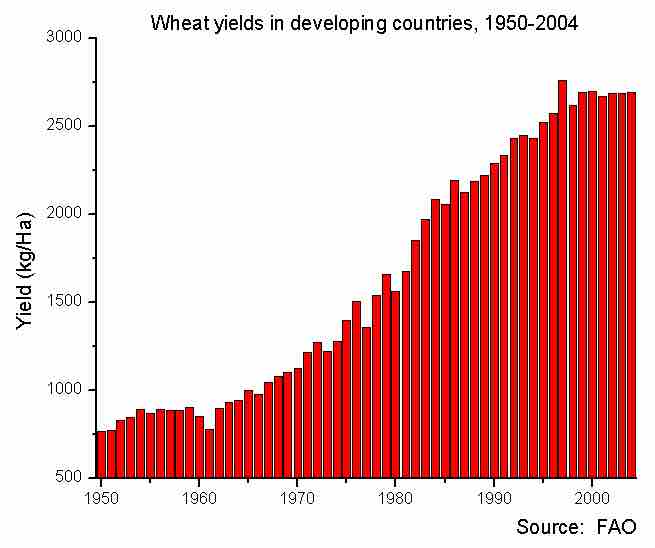Productivity measures the way in which an economic system or business can leverage available functional inputs to generate meaningful outputs. This concept drives economies towards higher degrees of efficiency in production and thus higher economic growth and standards of living. As a result, improving productivity is a critical objective for societies to increase their relative wealth. Technological advances play a crucial role in improving productivity, and thus the standard of living in a system.
Production-Possibility Frontier
Productivity growth is bound by what is called the production-possibility frontier (PPF), which essentially stipulates a series of maximum amounts of two commodities that can be generated using a fixed amount the relevant factors of production . In the context of a given PPF, only an increase in overall supply of inputs or a technological advancement will allow for the PPF to shift out and allow for an increase in potential outputs of both goods simultaneously (represented by point 'X' in the figure). The shift due to changes in technology represents increased productivity. This is a critical component in understanding the role of technology in productivity, as it is a primary influence on increasing the prospective production possibilities.

Production-Possibility Frontier (PPF)
This graph illustrates the varying theoretical takeaways from a PPF chart. On this, points B, C, and D all lie on a maximum output level, while A is representative of a realistic but inefficient amount. X is beyond the scope of the PPF graph, and thus requires a technological improvement or increase in supply.
Technological Advances: Past, Present, and Future
The variance in technological advances that have driven productivity upwards is remarkable, underlining the ongoing importance of focusing on technology as a primary change agent. Innovative advances in technologies can be either leaps or increments, although the larger technological advances tend to take the limelight. In general, there are a particularly notable categories:
- Energy: Historically, animals and humans were the primary energy input for the generation of products. This was extremely expensive and time-consuming relative to more modern ways to power things, and has been improved upon dramatically over time. Electricity, heat, steam, water, solar, and a wide variety of other energy capturing methodologies have dramatically increased efficiency while freeing up man hours.
- Transportation and Industrial Machinery: Trade has been a part of human history for nearly as long as civilizations knew of one another, bartering being the a central component of human interaction. The improvement of trade venues, such as boats, cars, planes, trains, etc. have enabled rapid increases in trade quantity and efficiency. Similarly, industrial machinery utilizing similar vehicles have enabled mass increases in scale and efficiency, particularly agriculture .
- Communication:Needless to say, the internet and mobile communications have rapidly expedited the transmission of knowledge, data, information, and networking. This has resulted in a massive increase in synergy across the world, alongside the development of economic learning and development.
- Logistics: Increases in technological systems is generally considered to be a tangible innovation, but is not limited to such. Improvements in the ways in which we do things is often just as useful. Henry Ford is a classic example of this, innovating the assembly line to maximize the efficiency the production process through strategic implementation of labor roles.
Implications on Productivity
Measuring the effects of technology on productivity is a difficult pursuit. It is generally approached through metrics such as Gross Domestic Product (GDP), GDP per capita, and Total Factor Productivity (TFP). The former two attempt to capture the overall output of a given economy from a macro-environmental perspective. The latter is slightly more interesting, attempting to measure technologically driven advancement through noting increases in overall output without increases in inputs. This is done through utilizing production function equations and identifying when the output is greater than the supposed input, implying an advance in the external technological environment. This system is more specifically tailored for technological change than GDP.

Wheat Yield
Over the past 60 years, wheat yield (PPF) has dramatically improved as a result of critical technological and logistic advancements.